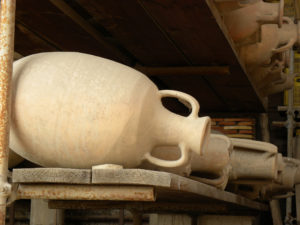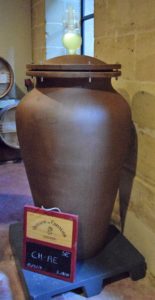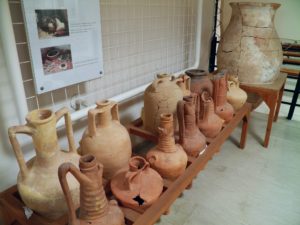Despite being an ancient technique that was abandoned thanks to inefficiencies in wine quality, the use of amphorae in winemaking has seen a resurgence. Historically, due to the high porosity of the earthenware material, amphorae often yielded wines that were exposed to too much oxygen during storage, so other ingredients such as honey and spices were added to make the wine more palatable. It is for this reason, and for the advancements of new

Photo courtesy Flickr user David Sivyer
technologies in wine storage (read: barrels and barriques), that amphorae use had died out (at least in Italy).
This modern resurgence in amphorae use in winemaking, according to peer-reviewed research, is due to the desire of winemakers to “rediscover” old winemaking techniques and traditions, and to reinvigorate what had been lost for many centuries. While the historical use of amphorae in winemaking is well-known, there hasn’t been too much in terms of scientific research on the quality of wine made from this type of storage system.
A study published in April 2017 in the journal Scientia Agriculturae Bohemica, aimed to perform a comparison of Chardonnay wine quality in wines made in-amphorae, barrels, and barriques, adding to the limited scientific knowledge that exists on the topic.
Brief Methods
Chardonnay grapes were harvested in 2014 from a single vineyard in S. Venanzio di Fossombrone, Italy. 80q of grapes were split into three treatments: amphorae (2, 225L each), barrels (2, 2000L each, non-toasted), and barriques (3, 225L each, toasted).
Quality (chemical and sensory) characteristics of the grapes/musts/wines were analyzed for the first 6 months of the winemaking process. The winemaking processes are described below (I left out some details for space considerations, so just ask if you need more information).
Amphorae winemaking: 8q of grapes were selected, destemmed, and manually placed into 2 amphorae. Grapes were then inoculated with Saccharomyces cerevisiae yeast. A cap of brushed cotton was placed on the top of the vessels during fermentation, to allow gases to escape while keeping contaminants out.
After alcoholic fermentation was complete, malolactic fermentation was started by inoculating with Oenococcus oeni. After malolactic fermentation was complete, dry ice was placed on top of the pomace and then the amphorae were sealed. In-amphorae maceration occurred until March of 2015 (roughly 6 months after harvest).
The pomace cap when the removed using a pump, and the wine was transferred to a stainless-steel tank until bottling (about 2 months later).
Barrels and Barriques winemaking: 70q of grapes were split up between the 2 barrels and 3 barriques. The grapes were destemmed, crushed, and cooled up to 10oC. Cooled grapes were then pressed using a pneumatic press until the wine-to-grape yield was about 72% and the juice transferred to a stainless-steel tank.
The juice was inoculated in the tank with Saccharomyces cerevisiae, and then transferred to either barrels or barriques for alcoholic fermentation. After alcoholic fermentation was complete, malolactic fermentation was started by inoculating with Oenococcus oeni.
Bâtonnage (stirring of the lees) was performed once per week for 3 months, and then one every two weeks for the next 2 months. Wine remained in the barrels/barriques until May 2015 (roughly 8 months after harvest). At this time, wine was transferred to stainless-steel tanks and later filtered and bottled.
Chemical analysis of the grapes occurred at maturation and at harvest (Brix/sugar, titratable acidity, malic acid, and pH).
Chemical analysis of the wines occurred a couple of weeks, 3 months, 5 months, and 6 months after harvest (alcohol content, total sulfur dioxide, titratable acidity, volatile acidity, pH, malic acid, lactic acid, and dry extract).
Sensory analysis was performed by a trained panel of 12 judges who were professors, researchers, and/or students. Panelists identified the sensory descriptors via a round table method, and then evaluated each of the three wines for these descriptors via a 4-point intensity scale (0 = no detected to 4 = highest intensity). Panelist also performed an overall judgment of each wine.
Selected Results
- Chemical analysis of the Chardonnay grapes at harvest resulted in the following values: 21.9oBrix sugar content, 7.60g/L titratable acidity, 2.25g/L malic acid, and 3.17 pH.
- Only the dry extract and volatile acidity were statistically significantly different between the different wines (though there were some value differences that didn’t quite make it to statistical significance).
- The researchers confirmed the higher dry extract in amphorae wines was due to the pomace cap maceration process.
- The amphorae wines showed higher volatile acidity, straw color, and perception of tannin compared to the barrel and barrique wines.
- Barrel and barrique wines showed higher vanilla flavor than amphorae wines.
- Amphorae wines showed lower titratable acidity than the barrel or barrique wines (not statistically significant).
- Volatile acidity was higher in barrique wines than barrel wines.
- Malolactic fermentation was complete much faster in amphorae wines than barrel or barrique wines.
- This again, according to the researchers, might be explained by the pomace cap, since there might have been wild lactic acid bacteria present, thus helping the process along faster than without the extra bacteria.
- Lactic acid levels were more or less similar between the three wines at the end of the winemaking process.
- Sensory analysis revealed:
- Amphorae wines had a “mature scent”, fewer green characteristics, and fewer Chardonnay varietal characteristics. Tannins were “elegant” and the wine had a “pleasing taste” (higher than the barrel or barrique wines). A spicy scent was noted, as well as a lack of vanilla character.
- Barrique wines had a lot of vanilla tones, and exhibited strong Chardonnay varietal characteristics. Characteristics noted were “fresh, harmony, and a remarkable woody flavor”. The panelists made a note to possibly blend this wine with the other wines to take the woody/oak characteristics down a notch.
- Barrel wines possessed the most Chardonnay varietal characteristics, and were considered to be the most balanced with spice, light oak, and vanilla character in addition to the fruit character. Panelists noted it was “full, balanced, fruity” and had a “persistent flavor”. Barrel wines were considered to be the “most complete” of the three treatment types.
Conclusions
The results of this study provide some information regarding the differences in Chardonnay wines from different winemaking techniques, including in-amphorae, barrel, and barrique vessels.
Overall, most of the chemistry was statistically similar between the three styles of wines, though the amphorae wines did have higher dry extract and volatile acidity than the barrel or barrique wines. Additionally, sensory analysis pegged the barrel wines as being the most balanced, while the amphorae wines exhibited the least Chardonnay varietal character of the lot. Despite these differences, it appears all the wines had many positive aspects to them,
that might serve well to be blended together for a more complex and complete wine.The biggest beef I have with this study is that there seem to be too many uncontrolled variables that could be influencing the results rather than just the storage vessels themselves. If you glance back up at the methods section, you see that the winemaking process for the amphorae and the barrels/barriques were completely different from one another. Well, all of the wines went through alcoholic and malolactic fermentation using the same microorganisms, however, the processes leading up to and then subsequently after those events were completely different.
The academic in me was screaming internally to see this, as in order to see solely the effect of the storage vessel on the finished wine, you need to control pretty much everything prior to bottling. I suppose I do understand that the winemaking processes for in-amphorae winemaking and barrel/barrique winemaking are going to be different in the real world, but as an academic it’s hard to draw any real conclusions from the results. The researchers themselves noted that the biggest differences noted between the three wine styles was due to the pomace maceration that occurred in the amphorae winemaking process. What if they didn’t use this technique or it was used the exact same way across the three styles of wine? How would the wines differ then? What would the differences be between the three wine styles if they all underwent the same fermentations and maceration processes, and differed only by the vessel in which these all took place? What would happen to these wines in the long run?
Despite these questions, the study seemed to show that wines made from all three vessels–amphorae, barrels, and barriques—were all good in their own way, but would be even better if they were blended together. Perhaps the amphorae could be a good option for a winemaker who wants to add some complexity to their wine by blending with barrel wines, or for a winemaker who is out for something completely unique and isn’t too picky about varietal character.
I admit, I know very little about in-amphorae winemaking other than what I’ve learned from this study, so I’d be interested to hear from winemakers who have dabbled with the technique and what they think about resulting wines.
Source:



3 comments for “A Comparison of In-Amphorae Winemaking to Barrels/Barriques in Chardonnay Wine”